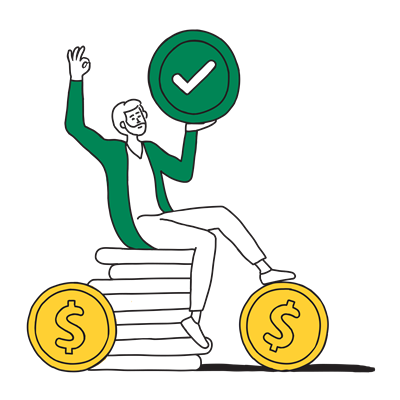I have federal student loans and want forgiveness
More than 45 million borrowers have federal student loans1 and forgiveness may help relieve some debt for those who qualify. But what about the rest of your federal student loan debt or your private student loan debt? Here’s how you can tackle it.
Explore Federal Student Loans
Tips for staying on top of your debt
Explore the tips
Visit StudentAid.gov
Know your loan types and repayment plans
Keep tabs on what you owe
Visit individual servicers’ websites
Explore the tips
Explore the tips
Visit StudentAid.gov
Know your loan types and repayment plans
Keep tabs on what you owe
Visit individual servicers’ websites
Visit StudentAid.gov
This is your one-stop shop for information about your federal student loans. Check your account. Remember, though, you won’t see information here about any private loans you may have.
Quick tip
Confirm your contact information is up to date.
Explore the tips
Explore the tips
Visit StudentAid.gov
Know your loan types and repayment plans
Keep tabs on what you owe
Visit individual servicers’ websites
Know your loan types and repayment plans
There’s more than one kind of federal aid, and it’s OK if you can’t remember the type you have. Take an inventory of your loans and grants and their details.
Quick tip
Loan simulators and charts can help you visualize your loans and different repayment scenarios.
Explore the tips
Explore the tips
Visit StudentAid.gov
Know your loan types and repayment plans
Keep tabs on what you owe
Visit individual servicers’ websites
Keep tabs on what you owe
In your account, review the remaining balances on all of your federal student loans. Review the interest rates and APR and use their simulator tools to see how long it will take to pay them.
Quick tip
Create a spreadsheet with each of your loan's details. Include their full balance, remaining balance and interest rates.
Explore the tips
Explore the tips
Visit StudentAid.gov
Know your loan types and repayment plans
Keep tabs on what you owe
Visit individual servicers’ websites
Visit individual servicers’ websites
Check your servicers’ websites for information on your loans. They know your records and can answer your questions. Not sure who your servicer is? Check out your account dashboard at StudentAid.gov.
Quick tip
Each servicer will provide different repayment options including deferment and income-based repayment. Call your servicers to learn your options.
Explore the tips
Visit StudentAid.gov
This is your one-stop shop for information about your federal student loans. Check your account. Remember, though, you won’t see information here about any private loans you may have.
Quick tip
Confirm your contact information is up to date.
Know your loan types and repayment plans
There’s more than one kind of federal aid, and it’s OK if you can’t remember the type you have. Take an inventory of your loans and grants and their details.
Quick tip
Loan simulators and charts can help you visualize your loans and different repayment scenarios.
Keep tabs on what you owe
In your account, review the remaining balances on all of your federal student loans. Review the interest rates and APR and use their simulator tools to see how long it will take to pay them.
Quick tip
Create a spreadsheet with each of your loans, the full balance, the remaining balance and the interest rate.
Visit individual servicers’ websites
Check your servicers’ websites for information on your loans. They know your records and can answer your questions. Not sure who your servicer is? Check out your account dashboard at StudentAid.gov.
Quick tip
Each servicer will provide different repayment options including deferment and income-based repayment. Call your servicers to learn your options.
Apply for federal student loan forgiveness
Check your eligibility
Figure out how much relief you may get
Apply for federal loan forgiveness
Check out other forgiveness options
How Much Can You Save?
Enter Your Current Loan
Compare a Citizens Loan
Federal loan refinancing: what to know

You can refinance federal loans with a private lender.
You can combine both federal and private loans.
Private loans are not eligible for forgiveness under the Biden administration’s plan.
There are income requirements for the federal forgiveness program.
Federal loan refinancing: what to know

You can refinance federal loans with a private lender.
Refinancing can be a good option, but you’ll lose the protections and benefits that come with federal student loans in exchange for your new student loan refinance benefits†. If you want to hold onto those federal benefits, you may want to consider other options through the federal government.
You can combine both federal and private loans.
Private loans are not eligible for forgiveness under the Biden administration’s plan.
There are income requirements for the federal forgiveness program.
Federal loan refinancing: what to know

You can refinance federal loans with a private lender.
You can combine both federal and private loans.
Both federal and private loans can be refinanced together with a private lender. But remember, you’ll lose access to any existing federal loan benefits.
Private loans are not eligible for forgiveness under the Biden administration’s plan.
There are income requirements for the federal forgiveness program.
Federal loan refinancing: what to know

You can refinance federal loans with a private lender.
You can combine both federal and private loans.
Private loans are not eligible for forgiveness under the Biden administration’s plan.
Your private loan isn’t covered by the recent forgiveness plan, even if it started as a federal loan. Generally, the plan covers most federal student loans.
There are income requirements for the federal forgiveness program.
Federal loan refinancing: what to know

You can refinance federal loans with a private lender.
You can combine both federal and private loans.
Private loans are not eligible for forgiveness under the Biden administration’s plan.
There are income requirements for the federal forgiveness program.
Borrowers are eligible if their individual annual income is less than $125,000 or $250,000 for married couples.
Did you know?
More than 40 million people could see their federal student loan debt reduced under the Biden administration’s forgiveness plan. And nearly 20 million could see their debt erased completely.2
